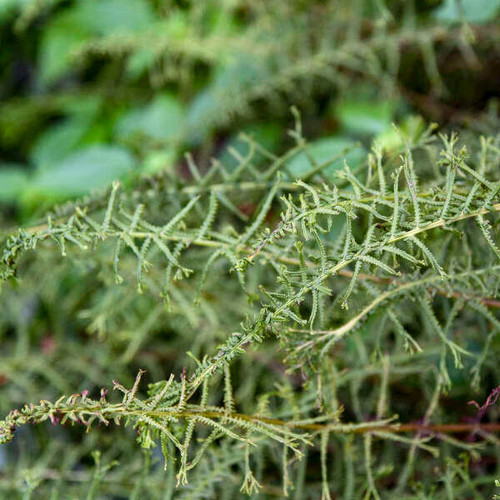Product Description
Athyrium filix-femina 'Frizelliae'a/k/a Fern-Tatting
Zones 4 to 8, perhaps zone 3;
Part shade to full shade.
Mature size 12 to 18 inch height, spreads 24to 36 inches.
'Frizelliae' is a dwarf, deciduous cultivar with narrow fronds on which the pinnae are rolled up tightly together instead of being open and lacy like other ferns. As a result, they look like delicate string of beads on a necklace. Plant it near the front of the border because every visitor to the garden is going to want to touch it!
Athyrium grows best in moist soil with a neutral to moderately acidic pH. Partial to full shade is best. To protect the crowns and tender shoots in the spring, it is best to leave the old fronds on the plant over the winter. They can be removed in the spring when the new fronds reach 6 inches tall. If division is necessary, do so in the spring. 'Frizelliae' will not come true if propagated from spores.
This is useful as a background plant in shade gardens and is also beautiful planted en masse along streams or woodland settings.
Royal Horticultural Society's Award of Garden Merit 1997
Other Details
The most important part of the plant is its root system. Healthy roots are the foundation of a healthy, vibrant plant. The type of plug container used is based on the specific needs of the plants. Perennials offered as bare root traditionally perform better when planted as bare root.Planted in a specialized mix, potted plants have well established root systems. Top growth stage will vary depending on the current life cycle and time of year when shipped. In Winter and early Spring dormant plants may be shipped. Dormant plants may be planted right away, even before the last frost date.
Most bare root varieties are field grown for at least one season, though Hemerocallis and Hosta are grown for two seasons. The bulk of the soil is removed during the harvesting process and the tops of most varieties are trimmed back to the crown. They are graded, packed in shredded aspen or sphagnum moss and stored in freezers until ready to be shipped.
See our Container Sizes and Bare Root Perennials pages for more information.
Plant information and care is provided in the Overview section, Plant Genus Page and general information is provided in the Planting Care & Guides. Additional questions can be asked on each Plant page.
Plant Spacing: Using the maximum mature spread or width of a plant to guide spacing, ensures space to grow to full size. To fill an area sooner, plant them closer together. Just remember, future thinning or transplanting may be needed.
Water: Keep a close eye on newly planted perennials, especially throughout the first growing year. Most early plant loss is due to too much or too little water!










